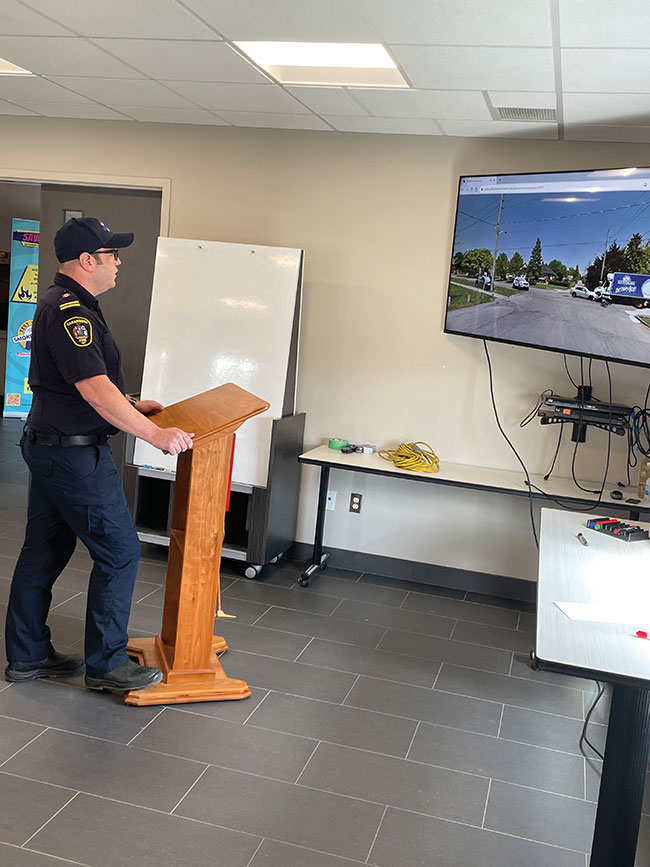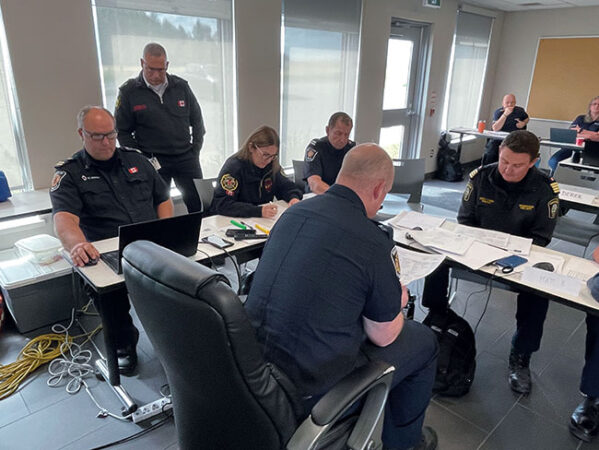
Features
Developing officers effectively
A unique approach to assessing incident command
March 24, 2024
By
Laura Aiken
 Innisfil Fire Rescue Service RTC hosted an instructor training certification course.
Photos courtesy of Fire Chief Brent Thomas
Innisfil Fire Rescue Service RTC hosted an instructor training certification course.
Photos courtesy of Fire Chief Brent Thomas Assessing the skillset of incident command and officer development in Ontario has a new partner in training.
Effective Command, an online incident command training tool with origins in the UK, is being rolled out in the province with the endorsement and support of the Ontario Association of Fire Chiefs (OAFC) and Ontario Fire Administration Inc. (OFAI).
Katherine Lamb founded Effective Command in the UK in 2015 as a behavioural marker framework to bridge the gap between academic research and fire service application. Lamb’s background is in the fire service and as a research scientist with a PhD.
The program is now being used by 95 per cent of UK fire departments to train, assess and record competence, she said.
“The three buzzwords I like to focus on are assertive, effective and safe,” said Lamb. “That’s what you’re striving to develop in your officers.”
She first presented the program to the OAFC at their 2022 annual general meeting.
“Off the back of that there’s been an incredible amount of energy, and impetus regarding command training, dedicated training to support officer development, and improving organizational efficiencies throughout Ontario,” said Lamb.
Following the initial presentation in 2022, the program was modified to address differences in UK and Canadian approaches to things like staffing and certain aspects of response. Differences aside, the program essence remains the same: “Develop the thinking firefighter who then becomes the thinking incident commander,” said Lamb. The thinking commander is articulated as one who can effectively deal with the unexpected.
Fundamentally, Effective Command assesses how the individual applies skill and technical knowledge, rather than scoring on the ability to remember procedural steps via memory. Understanding why someone makes the decision they did is a foundational aspect of how the evaluation.
Brent Thomas, fire chief for Innisfil/Bradford West Gwillimbury Fire and Rescue Service and board director for the OAFC, concurs with Lamb that the approach of Effective Command deviates from the memory-based testing that has been standard in Ontario. There is nothing wrong with this approach, said Thomas, but he said the ability to score well on a memory test doesn’t always correlate with the ability to command a scene. The feedback that follows the simulated scenario used for assessment will truly underscore the strengths and, in a constructive manner, the weaknesses of one’s performance, said Thomas. This leads to the development of a personal training plan that identifies areas where further development is needed. From the chief’s perspective, the scope broadens to show if all officers in the department need assistance in a particular area, which could highlight the need for an operational guideline or additional instruction.
Thomas said he also appreciates the hard data and KPIs that come with the program as it provides justification for allocating budget to an area of training.
The OAFC’s training and education committee is looking at developing a standardized officer development program that will support the Effective Command assessment tool, said Thomas. This standardized officer development approach would support Ontario’s strong mutual aid system.

The Effective Command assessment has 72 points and the results bundle in a database.
How the program works
The team delivering the evaluation generates a simulated scenario in which the candidate being assessed is in the role of commander. The simulation requires managing the scene, doing the 360 around the building if applicable, sending in radio report briefs, etc. The scenario comes to an end with the appropriate transfer of command to a platoon or district chief. The candidate then receives in-depth feedback on their performance from the assessor, and since it’s subjective, the assessor must be qualified to do so. Assessors become qualified by partaking in a 5-day instructor course that equips them with the knowledge to roll out the program in their department. With this type of practical assessment, as opposed to chiefly theory based, and it being newer to the Canadian fire service’s incident command training, Lamb strongly recommends the instructor training come first.
A recent course attendee had this to say: “It’s like no other training I’ve taken before. Best tool at our disposal for improvement across ALL organizational levels”
A key part of the feedback is a shift past passing judgement alone to a probing into the “why” of each decision, which is asked at each step of the review.
“This is a unique program, not like we’ve had in Ontario before and we haven’t had anything that gathers data or probes the reasoning behind the why decisions were made,” said Thomas.
From there, a decision-making rationale can be determined, as can an unveiling of the real gaps in understanding, as opposed to potentially dealing with a scenario by knowing a list of what to do.
“When something happens that is unexpected at an incident or there’s a dilemma to solve, they’ve got the skills to be able to step outside the box to manage the situation because you’ve equipped them with it [through Effective Command],” said Lamb.
The assessment has 72 points, the results of which are aggregated into an electronic database. Lamb noted that this data is helpful under cases of liability where a structure has been lost or there is an investigation, because the chief is able to provide evidence everyone was properly trained with the right skill sets to be making decisions at the scene. Lamb recommends training occur quarterly for officers as a minimum, using resources in the toolkit, and that assessment is periodic (tailored to the organization), but suggested as every three years. The program includes an annual subscription for the organization.
Jeremy Inglis, deputy chief with Central York Fire Services and treasurer for the OAFC board, has done Effective Command evaluation with the Burlington, Ont., fire department. He said the program goes beyond competent officer development to identify gaps in policy and procedure.
“It’s that verification training,” he said, adding that he realized the evaluation was part of risk assessment for the department. “You don’t know what you don’t know and the worst time to find that out is during an incident when you need to know. This gives you the opportunity.”
Effective Command also allows for the running of complex scenarios, like train derailments or large hazmat incidents, and is scalable for all size of departments. The program is accredited through multiple professional bodies and academic institutions.
Upcoming instructor courses in Ontario can be found through the OAFC and an association member rate has been established.
Print this page